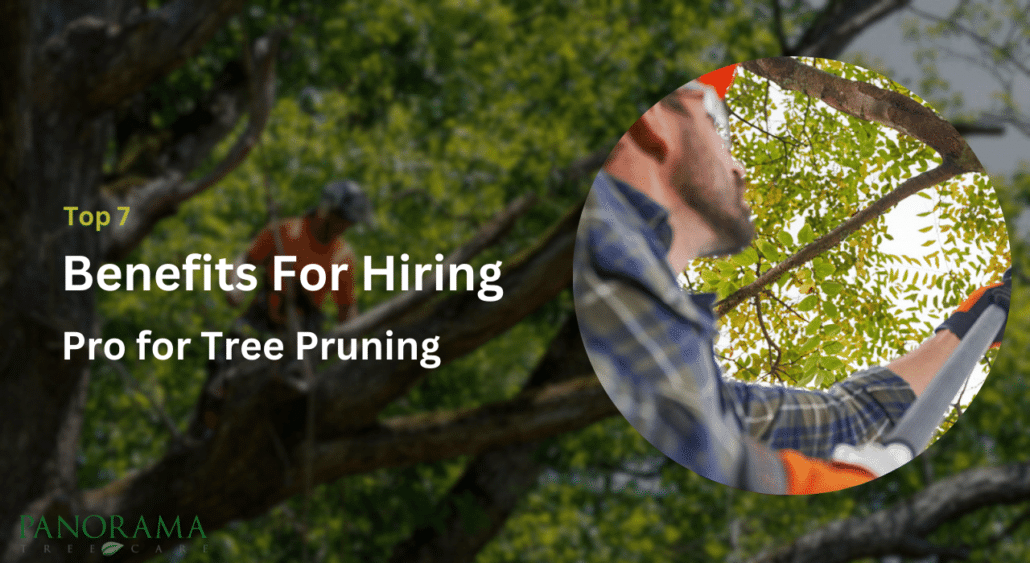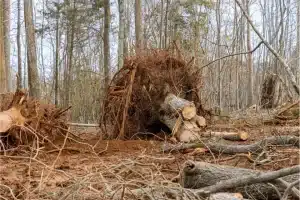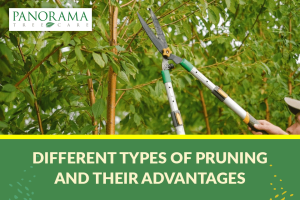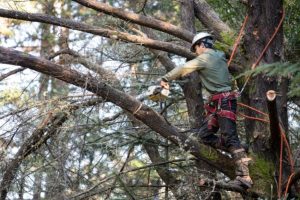Tree pruning is the strategic removal of selected branches, stems, or roots to improve the tree’s structure, appearance, and overall health.
While some homeowners attempt to prune themselves, hiring a professional arborist ensures the job is done safely and correctly.
Professional tree pruning services like us offer numerous advantages that can enhance your property’s curb appeal, prevent potential hazards, and promote the longevity of your trees.
Advantages of Professional Tree Pruning Services
Professional tree pruning services offer several benefits that homeowners and property managers can’t achieve with DIY methods. Let’s explore some of the key advantages:
Benefit #1: Improved Tree Health and Appearance
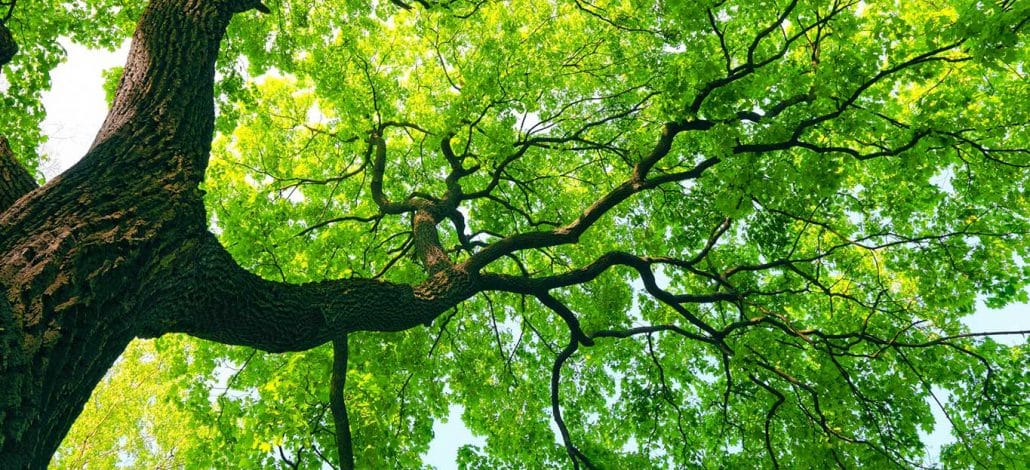
1. Certified Arborists Conduct Assessment: Before any pruning begins, certified arborists thoroughly assess the health and condition of the trees.
They inspect each tree carefully, looking for signs of disease, damage, or decay.
This assessment helps them identify which branches need to be pruned to improve the tree’s overall health and appearance.
2. Selective Removal of Dead, Damaged, or Diseased Branches: Once the assessment is complete, certified arborists selectively remove dead, damaged, or diseased branches.
These branches are not just unsightly; they can also pose serious risks to the tree’s health.
By removing them, arborists prevent the spread of disease and decay, allowing the tree to allocate its resources more effectively to healthy parts.
3. Enhancement of Natural Shape and Aesthetic Appeal: Professional tree pruning isn’t just about cutting branches; it’s about sculpting the tree to enhance its natural shape and beauty.
Certified arborists have an eye for aesthetics and know-how to prune trees in a way that enhances their overall appearance.
This can involve shaping the canopy, thinning out dense areas, or creating a more balanced silhouette.
4. Promotion of Overall Health and Vigor: By removing dead, damaged, or diseased branches and shaping the tree’s canopy, professional pruning promotes overall tree health and vigor.
It allows the tree to redirect its energy towards growth and development, rather than wasting resources on maintaining unhealthy branches.
This results in a stronger, more resilient tree that is better able to withstand environmental stressors.
5. Improved Air Circulation and Sunlight Penetration: Another critical aspect of professional tree pruning is improving air circulation and sunlight penetration within the tree’s canopy.
By selectively removing branches, arborists create space for air to flow more freely through the tree, reducing the risk of fungal diseases and promoting better overall health.
Additionally, increased sunlight penetration stimulates photosynthesis, allowing the tree to produce more energy and thrive.
Whether you’re focused on safety, beauty, or long-term growth, choosing skilled tree pruning Tampa Bay professionals ensures your trees are maintained with care and expertise tailored to our local climate.
Benefit #2: Increased Safety
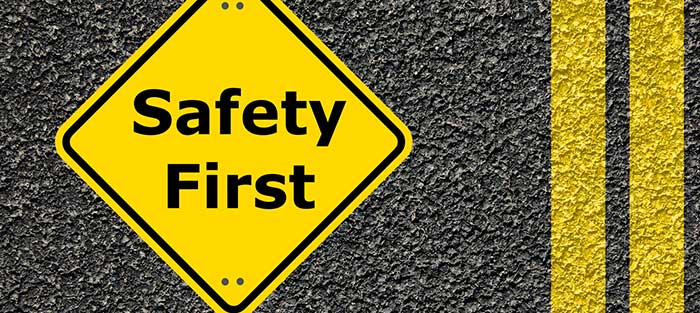
1. Risk Mitigation: Certified arborists prioritize safety above all else when it comes to tree care. One of the main ways they enhance safety is by identifying and mitigating potential risks associated with trees.
Overhanging or weak branches can pose significant hazards, especially during storms or high winds.
Professional pruning services address these risks by carefully assessing each tree and removing branches that could potentially fall and cause harm.
2. Removal of Hazardous Branches: Arborists have the expertise to identify weak, diseased, or dead branches that may be at risk of falling.
These branches are carefully pruned to eliminate the danger they pose to property or personal safety.
By proactively removing hazardous branches, arborists reduce the likelihood of accidents or property damage caused by falling limbs.
3. Prevention of Storm Damage: Regular pruning helps trees withstand severe weather conditions, such as storms or heavy winds.
By removing weak or overextended branches, arborists reduce the risk of branches breaking off and causing damage during inclement weather.
This not only protects property but also minimizes the potential for personal injury caused by falling debris.
4. Maintenance of Clearances: Professional pruning services also help maintain clearances around buildings, power lines, and walkways.
Overgrown branches can encroach on structures or obstruct pathways, posing safety risks to residents or pedestrians.
Arborists carefully trim branches to ensure adequate clearance, reducing the risk of accidents or injuries caused by branches impeding traffic or obstructing views.
5. Enhanced Visibility and Access: In addition to removing hazardous branches, professional pruning services improve visibility and access around trees.
By shaping the canopy and removing obstructive branches, arborists create a safer environment for pedestrians, drivers, and property occupants.
Improved visibility reduces the risk of accidents and enhances overall safety in residential and commercial settings.
Benefit #3: Prolonged Tree Lifespan
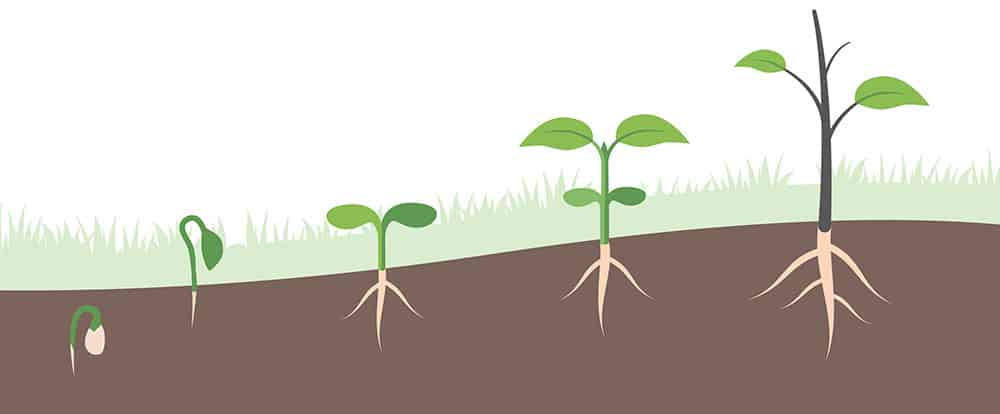
1. Strategic Pruning Techniques: Certified arborists are trained to employ strategic pruning techniques that promote the long-term health and vitality of trees.
This involves selectively removing branches that are competing for space or resources, such as sunlight, water, and nutrients.
By eliminating overcrowded or crossing branches, arborists reduce stress on the tree and encourage balanced growth.
2. Stress Reduction: Overcrowded branches can create competition for resources within the tree, leading to stress and reduced overall health.
Professional pruning services address this issue by thinning out the canopy and removing excess branches.
By reducing competition, arborists alleviate stress on the tree, allowing it to allocate its resources more efficiently and thrive.
3. Disease Prevention: Regular pruning plays a critical role in preventing the spread of diseases within trees.
Certified arborists carefully inspect trees for signs of disease or infection and selectively remove affected branches.
By removing diseased branches promptly, arborists prevent the disease from spreading further and compromising the overall health of the tree.
This proactive approach to disease prevention helps prolong the tree’s lifespan and preserves its structural integrity.
4. Enhanced Nutrient and Water Absorption: Trees require essential nutrients and water to support their growth and development.
However, competing or overcrowded branches may limit the tree’s ability to access these vital resources.
Professional pruning services address this issue by improving the tree’s ability to absorb nutrients and water.
By removing excess branches, arborists ensure that resources are distributed more evenly throughout the tree, promoting healthy growth and vitality.
5. Environmental Resilience: Trees face numerous environmental stressors, including extreme weather conditions, pests, and pollution.
Regular pruning helps trees withstand these stressors by promoting overall health and resilience.
By maintaining a balanced canopy and removing weak or damaged branches, arborists ensure that trees are better equipped to cope with environmental challenges over time.
Benefit #4: Controlled Growth and Size Management
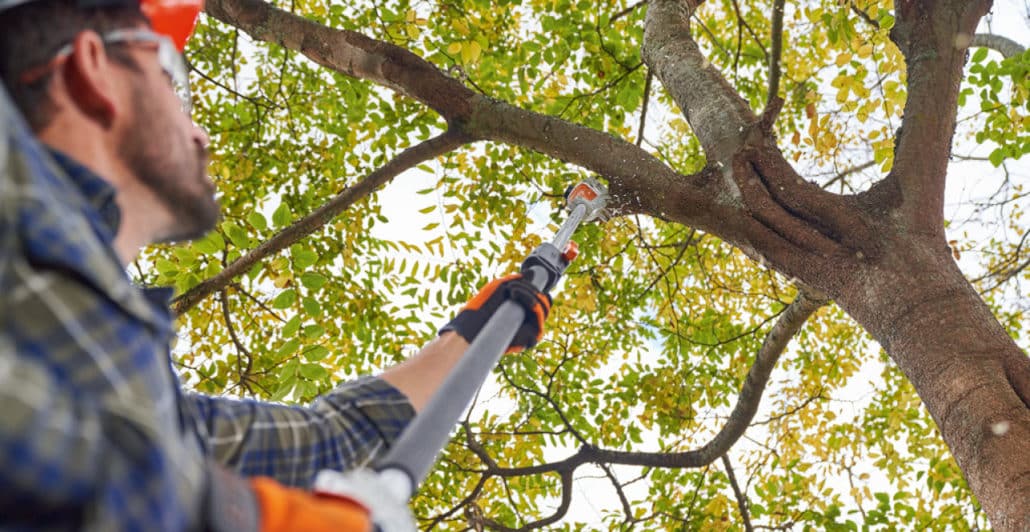
1. Strategic Pruning Techniques: Certified arborists employ specialized pruning techniques to control the growth of trees effectively.
These techniques may include crown reduction, crown thinning, and directional pruning.
By selectively removing specific branches, arborists can influence the direction and rate of growth, ensuring that trees remain within their designated spaces.
2. Clearance Maintenance: One of the primary objectives of professional tree pruning is to maintain adequate clearance from surrounding structures, such as buildings, power lines, and walkways.
Overgrown branches can pose safety hazards and cause damage to property if they come into contact with structures or utility lines.
Arborists carefully prune branches to create sufficient clearance, reducing the risk of accidents and property damage.
3. Aesthetic Considerations: In addition to safety concerns, professional tree pruning also addresses aesthetic considerations.
Overgrown or misshapen trees can detract from the overall appearance of a landscape. Arborists use pruning techniques to shape trees and maintain a visually pleasing silhouette.
By sculpting the canopy and removing excess growth, they enhance the aesthetic appeal of trees while ensuring they remain proportionate to their surroundings.
4. Prevention of Overcrowding: Overcrowded trees can compete for sunlight, water, and nutrients, leading to stunted growth and reduced vitality.
Professional pruning services address this issue by thinning out the canopy and removing excess branches.
By creating space between branches, arborists reduce competition and promote healthy growth. This prevents overcrowding and ensures that each branch receives adequate resources to thrive.
5. Health and Vigor: Controlled growth management is essential for maintaining the health and vigor of trees.
Overly dense canopies can restrict airflow and sunlight penetration, creating favorable conditions for pests and diseases.
By pruning trees to a manageable size, arborists improve air circulation and light exposure, reducing the risk of pest infestations and fungal infections.
This promotes overall tree health and vitality, ensuring that trees remain resilient and resistant to environmental stressors.
Benefit #5: Disease and Pest Prevention
1. Early Detection and Intervention: Certified arborists are trained to recognize the early signs of pest infestation or disease in trees.
During routine inspections, they carefully examine the foliage, branches, and trunk for any abnormalities or symptoms of distress.
By detecting issues early on, arborists can take proactive measures to address them before they escalate into more significant problems.
2. Selective Removal of Infected or Diseased Limbs: When signs of pest infestation or disease are identified, professional tree pruning involves the selective removal of infected or diseased limbs.
These limbs act as entry points for pathogens or pests, allowing them to spread throughout the tree if left unchecked.
By promptly removing affected branches, arborists contain the spread of disease and prevent further damage to the tree’s health.
3. Prevention of Pathogen Spread: Certain diseases, such as fungal infections, can spread rapidly within a tree if proper precautions are not taken.
Professional pruning helps prevent the spread of pathogens by removing infected branches and creating physical barriers to their transmission.
This containment strategy limits the impact of diseases and protects the overall health of the tree.
4. Improvement of Air Circulation: Adequate air circulation is essential for maintaining the health of trees and mitigating the risk of fungal infections.
Dense foliage and overcrowded branches can restrict airflow within the canopy, creating a favorable environment for fungal growth.
Professional pruning services address this issue by thinning out the canopy and removing excess growth. By improving air circulation, arborists reduce the likelihood of fungal infections and other common tree ailments.
5. Enhancement of Tree Vigor: Healthy, vigorous trees are better equipped to resist pest infestations and diseases.
Professional pruning promotes tree vigor by removing dead, damaged, or weakened branches that may be vulnerable to pests or pathogens.
By enhancing the overall health of the tree, arborists strengthen its natural defenses against external threats, reducing the likelihood of infestation or disease occurrence.
Benefit #6: Enhanced Fruit or Flower Production
1. Optimizing Branch Structure: Certified arborists carefully assess the branch structure of fruit-bearing or flowering trees to identify opportunities for improvement.
They selectively remove branches that are overcrowded, crossed, or competing for space. By thinning out the canopy and shaping the branches, arborists create an optimal framework for fruit or flower production.
This allows for better air circulation and sunlight penetration, which are essential for healthy growth and development.
2. Stimulating New Growth: Professional pruning stimulates the growth of new branches and buds, which are essential for fruit or flower production.
Arborists strategically prune older or unproductive branches to encourage the growth of new shoots and flowering spurs.
This renewal process revitalizes the tree and promotes vigorous growth, leading to increased fruit or flower yields in subsequent seasons.
3. Enhancing Light Exposure: Sunlight is a critical factor in the photosynthesis process, which is essential for the production of fruits and flowers.
Professional pruning services optimize sunlight exposure by removing excess foliage and opening up the canopy.
This allows sunlight to penetrate deeper into the tree, reaching all parts of the branches and stimulating flower bud formation. Adequate light exposure ensures that flowers receive the energy they need to develop into healthy fruits.
4. Promoting Air Circulation: Proper air circulation is crucial for preventing fungal diseases and promoting healthy fruit or flower development.
Professional pruning helps improve air circulation within the canopy by reducing the density of branches and foliage.
This reduces the risk of moisture buildup and fungal growth, ensuring that fruits or flowers remain healthy and disease-free.
5. Facilitating Nutrient Distribution: Trees allocate resources such as water, nutrients, and carbohydrates to different parts of the plant based on demand.
Professional pruning ensures that resources are distributed more efficiently to support fruit or flower production.
By removing overcrowded or unproductive branches, arborists enable the tree to redirect resources to developing fruits or flowers, leading to improved quality and yields.
6. Removing Non-Productive Branches: Arborists identify and remove non-productive branches that do not contribute to fruit or flower production. These branches may be weak, diseased, or excessively shaded, hindering the tree’s ability to produce fruits or flowers. By eliminating these branches, arborists ensure that the tree can focus its energy and resources on developing healthy fruits or flowers, resulting in enhanced production.
Benefit #7: Professional Expertise and Safety
1. Extensive Training and Certification: Certified arborists undergo rigorous training and education to acquire the specialized skills and knowledge required for tree care.
They study tree biology, growth patterns, pruning techniques, and safety protocols to become experts in their field.
This comprehensive training ensures that arborists have the expertise to assess tree health, identify issues, and perform pruning tasks safely and effectively.
2. Adherence to Industry Best Practices: Professional tree pruning services are guided by industry best practices and standards established by organizations such as the International Society of Arboriculture (ISA) and the Tree Care Industry Association (TCIA).
These standards outline proper pruning techniques, safety protocols, and ethical guidelines for tree care professionals to follow.
By adhering to these standards, certified arborists ensure that pruning activities are conducted in a manner that promotes tree health and safety.
3. Specialized Equipment and Tools: Professional tree pruning services come equipped with specialized tools and equipment specifically designed for tree care tasks.
These tools, such as pruning shears, loppers, chainsaws, and aerial lifts, enable arborists to perform pruning tasks safely and efficiently.
Additionally, certified arborists are trained to use this equipment properly, reducing the risk of accidents or injuries during pruning operations.
4. Safety Protocols and Risk Management: Safety is paramount in tree care, and certified arborists prioritize safety at all times.
They conduct thorough risk assessments before starting any pruning work to identify potential hazards and develop mitigation strategies.
Arborists follow strict safety protocols, such as wearing personal protective equipment (PPE), establishing work zone boundaries, and using proper climbing techniques to minimize risks to themselves, bystanders, and property.
5. Insurance Coverage: Professional tree pruning services typically carry liability insurance to protect against potential property damage or personal injury claims.
This insurance provides added peace of mind for homeowners and property managers, knowing that they are protected in the event of accidents or unforeseen incidents during pruning operations.
Hiring insured services mitigates financial risks and ensures that any damages or liabilities resulting from pruning activities are covered.
6. Continuous Professional Development: Certified arborists are committed to ongoing professional development to stay abreast of the latest industry trends, techniques, and technologies.
They attend training seminars, workshops, and conferences to enhance their skills and knowledge and stay current with industry advancements.
This commitment to continuous learning ensures that arborists remain at the forefront of tree care practices and can provide the highest level of service to their clients.
Hiring professionals for certified tree pruning in Tampa ensures each cut supports the tree’s health, appearance, and long-term survival—done safely and correctly from start to finish.
Conclusion
In conclusion, professional tree pruning services offer a multitude of benefits that contribute to the health, safety, and aesthetics of your landscape.
From improved tree health and appearance to increased safety and disease prevention, the advantages of hiring certified arborists are undeniable.
Ready to give your trees the expert care they deserve? Contact us today to schedule a consultation with our certified arborists and protect your landscape investment.

